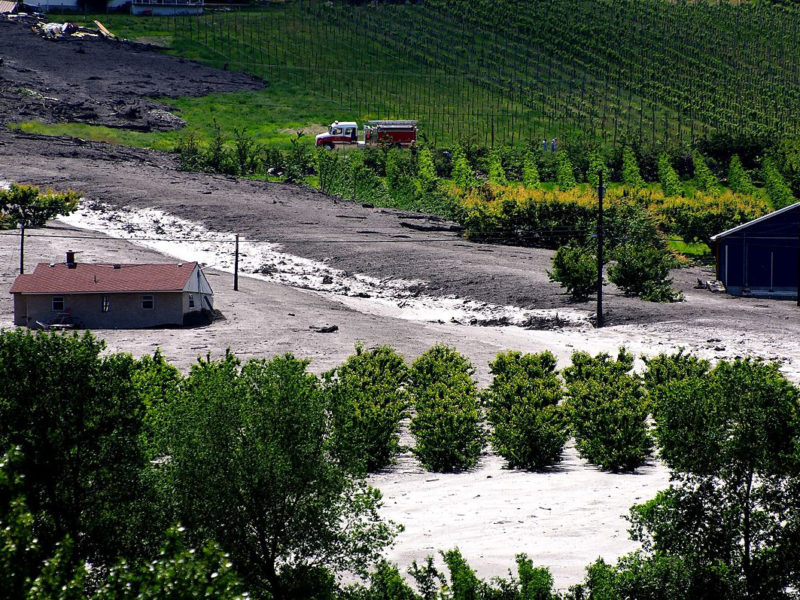VICTORIA – BC’s auditor general says the province has failed to ensure dam owners comply with dam safety regulations, raising the risk of failures such as the 2010 collapse of the Testalinden dam on rangeland south of Oliver that swept away houses, vineyards and farm equipment.
But the report, released September 14, stopped short of recommending the province commit more money to helping dam owners meet their obligations. It instead called on the province to boost enforcement activities. Provincial regulations give owners responsibility for dam safety while the province oversees compliance to mitigate the risk to people, property and the environment.
“Our audit concluded that the ministry has not effectively overseen the safety of dams in BC,” auditor general Michael Pickup said in releasing the report. “Dams are dangerous, and it is crucial that they be properly maintained to minimize their risk of failing. Failures can be disastrous for people, the environment and property.”
The report was based on a year-long investigation of the BC Ministry of Forests, Lands, Natural Resource Operations and Rural Development (FLNRORD) with respect to dam oversight. It found the province promoted compliance with the province’s dam safety requirements but “did not adequately verify or enforce compliance” as required under the Water Sustainability Act.
“They are not doing what they set out to do in terms of compliance,” says Pickup.
Of the 1,900 dams across the province, 1,000 are designated “high risk,” meaning a failure could kill people and damage the environment and property. The impact of failures at the other 900 dams is lower, only damaging the owner’s property.
The investigation uncovered a number of troubling facts. For example, at least 196 dams are missing from ministry records.
“The ministry should have been regulating some of those,” says Pickup.
In addition, 63% of dam records sampled lacked key information, such as emergency contacts and dam height.
Moreover, a sample of records found that 33% of operating manuals and 27% of dam emergency plans submitted to the ministry were not reviewed three or more years after submission. Reviews of high-consequence dams are backlogged. The average time to accept safety reports was 20 months; some took eight years.
Competing priorities in regional offices and a shortage of staff contribute to the backlogs.
Just three of the province’s 10 dam safety officers are full time. But those officers are responsible for a caseload that ranges from 47 to 427 dams.
Using estimates from program staff, the audit “determined that the ministry would need another five central and five regional staff to meet all aspects of the program’s mandate.”
The report makes nine recommendations for improving the province’s oversight of dam safety, including informing all dam owners of their regulatory obligations, improving processes to verify dam owner compliance, improving monitoring of compliance and enforcement activities and strengthening performance measures and targets.
The province accepted all nine of the auditor’s recommendations, however it remains to be seen what action will be taken.
“Our recommendations are not prescriptive,” says Pickup. “It is the government’s job to create detailed policy. They need to figure out, given what we have found, how they want to monitor compliance and enforcement.”
Financial burden
Ranchers own about 900 dams, or 60% the all the dams in BC. Of these, 125 are considered high-consequence. But the BC Cattlemen’s Association say the audit did not address the top barrier to compliance – money to complete the work.
“We are disappointed that there was no mention of the regulatory and financial burden that comes with dam ownership,” says BCCA assistant general manager Elaine Stovin.
Dam owners are required to comply with the regulatory requirements and cover the cost of dam maintenance and upkeep. Stovin doesn’t think that’s fair given the multiple public benefits dams provide.
“Water stored in dams provides such a range of benefits and values to a community from flood control, habitat protection, food production, fire suppression and a variety of recreation opportunities,” she notes. “But the entire cost of the dam is the responsibility of the owner.”
The costs are significant.
A study of dam costs and benefits by national accounting firm MNP for ranchers in 2016 estimated that the average cost to operate a high-risk dam was $14,425 a year while a low-risk dam cost $1,950 a year.
But the dam rating is frequently out of the owner’s control.
“A rancher, of course, has no say as to whether a housing development goes in downstream of their dam, but a development below a dam would certainly increase the consequences if the dam were to fail,” Stovin points out. “A higher risk leads to a higher consequence classification and more costs for maintaining the dam.”
The dam owner ends up paying more money to reduce a risk they can’t control. Moreover, higher risk dams must complete a safety review every 7-10 years at a cost of up to $50,000. And, as the audit pointed out, it can take years for provincial staff to review these.
Stovin says dam safety has been a very important issue for cattlemen for over 10 years.
“We have resolutions brought forward at our AGMs and this has been a key ask when we present to the province’s finance committee every year,” she says.
BC Cattlemen and Ducks Unlimited prepared a discussion document on water storage in BC that they presented to FLNORD as well as the environment and agriculture ministries in July 2020. The document made several suggestions for addressing funding challenges associated with dam maintenance.
Stovin says this summer’s unprecedented heat wave, drought and wildfires point to the need for the province to prioritize the province’s water storage capacity. Producers are telling her that the increased costs put them in a position where they are looking to decommission their dams.
“Given the summer we have just had, I don’t think we can afford to lose any water storage capacity in our province,” she says.


 Cheesemakers felt the heat this summer
Cheesemakers felt the heat this summer